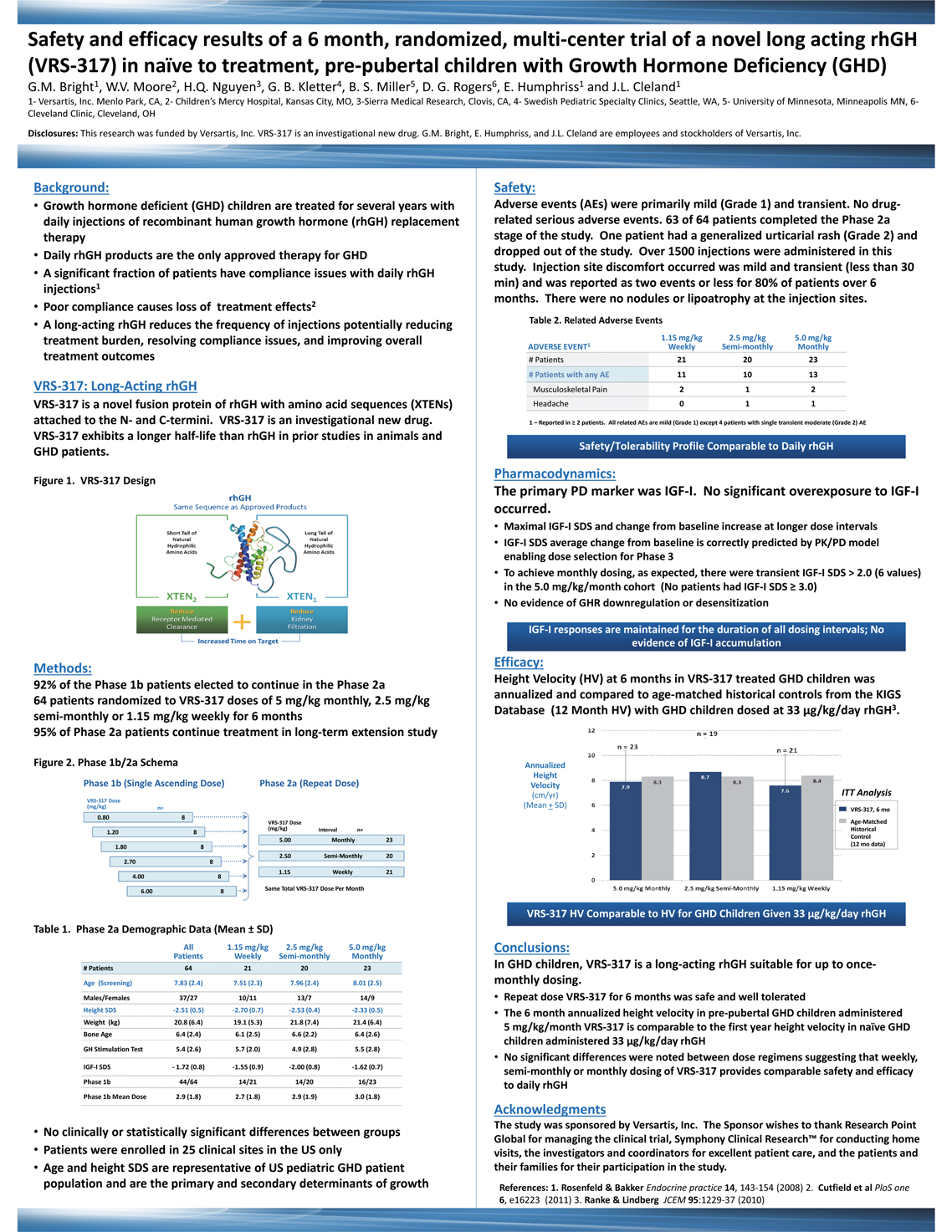Attached files
| file | filename |
|---|---|
| 8-K - 8-K - Aravive, Inc. | d791341d8k.htm |
Exhibit 99.1

Safety and efficacy results of a 6 month, randomized, multi center trial of a novel long acting rhGH (VRS 317) in naïve to
treatment, pre pubertal children with Growth Hormone Deficiency (GHD)
G.M. Bright1, W.V. Moore2, H.Q. Nguyen3, G. B. Kletter4, B. S. Miller5, D. G. Rogers6, E.
Humphriss1 and J.L. Cleland1
1 Versartis, Inc. Menlo Park, CA, 2 Children’s Mercy Hospital, Kansas City, MO, 3 Sierra Medical Research, Clovis, CA, 4 Swedish
Pediatric Specialty Clinics, Seattle, WA, 5 University of Minnesota, Minneapolis MN, 6
Cleveland Clinic, Cleveland, OH
Disclosures: This research was funded by Versartis, Inc. VRS 317 is an investigational new drug. G.M. Bright, E. Humphriss, and J.L. Cleland are employees and stockholders of
Versartis, Inc.
Background:
Growth hormone deficient (GHD) children are
treated for several years with daily injections of recombinant human growth hormone (rhGH) replacement therapy
Daily rhGH products are the only approved therapy
for GHD
A significant fraction of patients have compliance issues with daily rhGH
injections1
Poor compliance causes loss of treatment effects2
A long acting rhGH reduces the frequency of injections potentially reducing
treatment burden,
resolving compliance issues, and improving overall
treatment outcomes
Safety:
Adverse events (AEs) were primarily mild (Grade 1) and transient. No drug related serious adverse events. 63 of 64 patients completed the Phase 2a stage of the
study. One patient had a generalized urticarial rash (Grade 2) and dropped out of the study. Over 1500 injections were administered in this study. Injection site discomfort occurred was mild and transient (less than 30 min) and was reported as two
events or less for 80% of patients over 6 months. There were no nodules or lipoatrophy at the injection sites.
Table 2. Related Adverse Events
VRS 317: Long Acting rhGH
VRS 317 is a novel fusion protein of rhGH with amino acid sequences
(XTENs) attached to the N and Cermini. VRS 317 is an investigational new drug. VRS 317 exhibits a longer half life than rhGH in prior studies in animals and GHD patients.
Figure 1. VRS 317 Design
Methods:
92% of the Phase 1b patients elected to continue in the Phase 2a
64 patients randomized to VRS
317 doses of 5 mg/kg monthly, 2.5 mg/kg
semi monthly or 1.15 mg/kg weekly for 6 months
95% of Phase 2a patients continue treatment in long term extension study
Figure 2. Phase 1b/2a
Schema
Phase 1b (Single Ascending Dose) Phase 2a (Repeat Dose)
VRS 317 Dose
(mg/kg)
Table 1. Phase 2a Demographic Data (Mean ± SD)
All
Patients 1.15 mg/kg
Weekly 2.5 mg/kg
Semi monthly 5.0 mg/kg
Monthly
# Patients 64 21 20 23
Age (Screening) 7.83 (2.4) 7.51 (2.3) 7.96 (2.4) 8.01 (2.5)
Males/Females 37/27 10/11 13/7
14/9
Height SDS 2.51 (0.5) 2.70 (0.7) 2.53 (0.4) 2.33 (0.5)
Weight (kg) 20.8
(6.4) 19.1 (5.3) 21.8 (7.4) 21.4 (6.4)
Bone Age 6.4 (2.4) 6.1 (2.5) 6.6 (2.2) 6.4 (2.6)
GH Stimulation Test 5.4 (2.6) 5.7 (2.0) 4.9 (2.8) 5.5 (2.8)
IGFI SDS 1.72 (0.8) 1.55 (0.9)
2.00 (0.8) 1.62 (0.7)
Phase 1b 44/64 14/21 14/20 16/23
Phase 1b Mean Dose 2.9
(1.8) 2.7 (1.8) 2.9 (1.9) 3.0 (1.8)
No clinically or statistically significant differences between groups
Patients were enrolled in 25 clinical sites in the US only
Age and height SDS are
representative of US pediatric GHD patient population and are the primary and secondary determinants of growth
ADVERSE EVENT1
1.15 mg/kg
Weekly
2.5 mg/kg
Semi monthly
5.0 mg/kg Monthly
# Patients 21 20 23
# Patients with any AE 11 10 13
Musculoskeletal Pain 2 1 2
Headache 0 1 1
1 – Reported in 2 patients. All related AEs are mild (Grade 1) except 4
patients with single transient moderate (Grade 2) AE
Pharmacodynamics:
The
primary PD marker was IGFI. No significant overexposure to IGFI
occurred.
Maximal IGFI SDS and change from baseline increase at longer dose intervals
IGFI SDS average change from baseline is correctly predicted by PK/PD model
enabling dose selection for Phase 3
To achieve monthly dosing, as expected,
there were transient IGF I SDS > 2.0 (6 values)
in the 5.0 mg/kg/month cohort (No patients had IGF I SDS 3.0)
No evidence of GHR downregulation or desensitization
IGFI responses are maintained for the
duration of all dosing intervals; No
evidence of IGF I accumulation
VRS 317
HV Comparable to HV for GHD Children Given 33 µg/kg/day rhGH
Conclusions:
In GHD children, VRS 317 is a long acting rhGH suitable for up to once
monthly dosing.
Repeat dose VRS 317 for 6 months was safe and well tolerated
The 6 month annualized height velocity in pre pubertal GHD children administered
5 mg/kg/month VRS 317 is comparable to the first year height velocity in naïve GHD
children administered 33 µg/kg/day rhGH
No significant differences were
noted between dose regimens suggesting that weekly, semi monthly or monthly dosing of VRS 317 provides comparable safety and efficacy to daily rhGH
Acknowledgments
The study was sponsored by Versartis, Inc. The Sponsor wishes to thank Research Point Global for managing the clinical trial, Symphony Clinical Research™ for
conducting home visits, the investigators and coordinators for excellent patient care, and the patients and their families for their participation in the study.
References: 1. Rosenfeld & Bakker Endocrine practice 14, 143 154 (2008) 2. Cutfield et al PloS one
6, e16223 (2011) 3. Ranke & Lindberg JCEM 95:1229 37 (2010)
